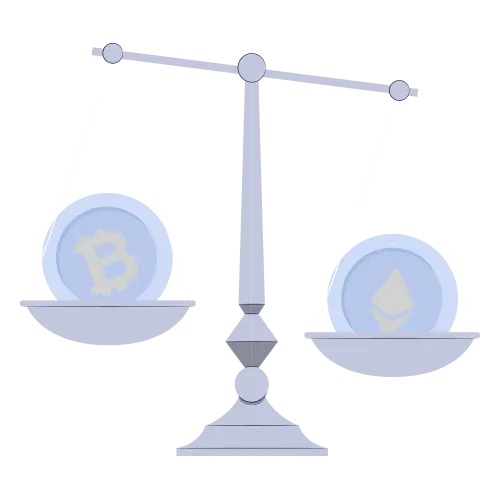5 Cryptocurrencies to Consider for Your 2025 Investment Portfolio: Expert Guide

- Key Factors in Choosing Cryptocurrencies for Future Investment
- Technology and consensus
- Use case and adoption
- Development team and roadmap
- Network security and decentralization
- Market sentiment and liquidity
- Diversification and risk management
- Bitcoin – The King of Cryptocurrencies
- Ethereum – The Leader in Smart Contracts
- Solana – Speed and Innovation in Blockchain
- Polkadot – Connectivity Between Blockchains
- Bottom line
- Avalanche – Rapid Growth and High Flexibility
- Important Points Before Investing in Cryptocurrencies
- Volatility
- Regulatory uncertainty
- Do your own research
- Security practices
- Start small and diversify
- Long-term view
- Conclusion and Summary
I remember the first time I bought Bitcoin – it felt like exploring uncharted territory. Fast-forward to 2025, and the crypto world has matured enormously. Today about 6.8% of people globally (over 560 million users) hold cryptocurrency. Massive institutional interest (think Bitcoin ETFs) and innovations in blockchain tech make this an exciting time to consider building a crypto investment portfolio. In this article, we’ll highlight five top cryptocurrencies worth watching in 2025 and explain the factors that make each one stand out. Along the way, we’ll share expert insights so you feel confident choosing the right mix for your goals.
Key Factors in Choosing Cryptocurrencies for Future Investment
Before picking coins, it’s important to know what makes a project promising. Consider these criteria when evaluating any cryptocurrency:
Technology and consensus
Does the blockchain use robust technology (Proof-of-Stake, scalable sharding, etc.)? For example, Ethereum’s continued upgrades (like staking after the Merge) or Solana’s fast proof-of-history design give them an edge.
Use case and adoption
A crypto should solve real problems or have strong demand. Bitcoin is prized as “digital gold” (a scarce store of value). Ethereum thrives as a smart-contract platform powering DeFi and NFTs. Altcoins like Avalanche and Polkadot offer specialized features (rapid transaction speeds or cross-chain bridges).
Development team and roadmap
A skilled team with a clear plan boosts confidence. Check if major updates are planned (Ethereum’s roadmap beyond 2024, Polkadot 2.0 upgrades).
Network security and decentralization
Large networks with many validators or miners (e.g. Bitcoin and Ethereum have vast security) are generally safer. Look at staking metrics: by 2025 over 1.04M Ethereum validators were active, securing the chain.
Market sentiment and liquidity
Well-known coins have deeper markets. Bitcoin and Ethereum trades in and out of dips in sync with market cycles, often stabilizing on corrections. See if projects attract institutional interest (e.g. $138B+ in Bitcoin ETF assets by mid-2025).
Diversification and risk management
Experts recommend mixing large-cap “stars” like Bitcoin/Ethereum with medium/high-growth altcoins. Diversification across sectors (infrastructure, DeFi, NFTs, etc.) can reduce risk. In short, blend stable blue-chips with a few innovative up-and-comers.
Keeping these factors in mind will help you select projects with real potential and avoid hype. Now let’s look at our top five picks for 2025.
Bitcoin – The King of Cryptocurrencies
Bitcoin, the original cryptocurrency, remains the anchor of any crypto portfolio. It’s the largest coin by market cap and famously capped at 21 million coins (making it scarce like gold). By 2025, many investors view Bitcoin as “digital gold” – a hedge or store of value. Big developments are afoot: in January 2024 the first U.S. spot Bitcoin ETFs were approved, allowing retirement funds and traditional portfolios to hold BTC easily. As of mid-2025, over $138 billion sits in Bitcoin ETFs. This institutional demand has helped calm Bitcoin’s swings: its 30-day volatility has recently hovered around 35%, much lower than past bull cycles.
Bitcoin’s strength is its proven track record and brand recognition. Every year more people and companies accept or invest in Bitcoin. Still, it’s not without risk. I always remind myself: Bitcoin’s value can spike or drop dramatically, so it’s best used as a long-term holding. When I first bought Bitcoin back in 2017, it felt volatile – and it was! These days many see it as a core asset that can stabilize a crypto portfolio. In short: Bitcoin’s dominance and limited supply make it a must-watch 2025 pick. If you include Bitcoin in your investment mix, you’re banking on the “digital gold” thesis – but remember to buy only what you can hold through turbulence.
Ethereum – The Leader in Smart Contracts
If Bitcoin is gold, Ethereum is oil – powering much of the crypto economy. Ethereum introduced smart contracts, enabling decentralized apps (dApps), decentralized finance (DeFi), NFT marketplaces, and more. By 2025, Ethereum remains the #2 coin by market cap (about 18–19% of total crypto value) and dominates DeFi. In fact, Ethereum’s Total Value Locked (TVL) hit $84 billion in June 2024, leaping 17% in a week, underscoring its lead in DeFi. Developers and institutions flock to Ethereum: many stablecoins (USDT, USDC) and major tokens run on it, and layer-2 solutions (like Arbitrum and Optimism) further boost capacity.
Ethereum also continues evolving. Its switch to Proof-of-Stake (the 2022 “Merge”) greatly reduced energy use and opened staking rewards to holders. By March 2025, over 30.2 million ETH (25% of supply) was staked, with more than 1.04 million active validators securing the network. Upcoming upgrades (like “proto-danksharding” in EIP-4844) aim to cut transaction costs further. In plain terms: Ethereum’s technology and massive ecosystem give it serious staying power. Its broad use cases – from DeFi loans to NFT trades – suggest steady demand. Many analysts predict Ethereum’s market cap could grow substantially if these upgrades pay off.
In practice, that means Ethereum could offer growth tied to innovation. A few anecdotes illustrate its influence: In 2024’s boom, Ethereum not only saw surging ETH prices, but projects like MakerDAO, Lido, and Uniswap saw record use. The developer community on Ethereum is huge – nearly 127 million active wallets by Q1 2025 – meaning an army of users and builders. For anyone building a 2025 crypto portfolio, Ethereum’s proven tech and versatility make it a leading pick among smart-contract blockchains.

Solana – Speed and Innovation in Blockchain
Solana is all about speed and low costs. Its unique architecture lets it handle thousands of transactions per second with fees pennies on the dollar. This raw performance has made Solana a darling for things like high-frequency trading, token launches, and NFT minting. In 2024 Solana saw a wild ride: SOL’s price hit a new all-time high around $263 as the coin rebounded strongly from earlier lows. Why the comeback? Partly because crypto funds (like Pantera Capital) bought up SOL tokens, absorbing selling pressure and signaling faith in Solana’s vision.
One big factor fueling Solana is its ease of token creation. Unlike on Ethereum, developers don’t need to write a new smart contract from scratch for each token. Solana’s architecture lets anyone launch tokens instantly. This led to a boom of new projects and even meme coins on Solana; platforms like pump.fun generated hundreds of millions in 2024, capitalizing on quick launches. Such activity highlights Solana’s strength: it can handle extremely high transaction loads smoothly and attract a vibrant community.
That said, Solana isn’t perfect. It’s had notable outages – for instance, a network shutdown in Feb. 2024 just short of its promised 1-year uptime. (That reset its “remove beta tag” countdown.) More hiccups came during an April hackathon, when some users couldn’t get their transactions to go through quickly. The Solana team is working to improve stability, but these events are a reminder: high performance can come with growing pains.
Looking at usage, Solana has seen big institutional moves too: Stripe now accepts Solana payments, and PayPal launched its USD stablecoin on Solana, and multiple Solana ETF applications are in the works. In short, Solana’s innovations make it a major player in NFTs, DeFi, and payments – but it requires a bit more comfort with risk. Its story shows that an altcoin can race ahead through speed and creative use cases, even amid volatility. If you bet on Solana, you’re banking on the power of fast, cheap transactions and a young ecosystem that may keep surprising us.
Polkadot – Connectivity Between Blockchains
Polkadot’s motto could be “many chains are better than one.” It’s a multichain platform designed to let blockchains talk to each other. The Polkadot network is built around a central Relay Chain (for shared security) and multiple parachains (independent blockchains that attach to it). This design promises great interoperability: a parachain can trustlessly send messages to other parachains, opening cross-chain DeFi and data sharing. By 2025, Polkadot has secured billions in DOT (the native token) to back its parachains: early auctions saw a whopping $3.5 billion in DOT staked across projects. That shows serious investor confidence in Polkadot’s model.
Technically, Polkadot has been updating rapidly. In 2024 it rolled out “Polkadot 2.0” upgrades like Asynchronous Backing (launched May 2024) and Agile Coretime (Sept 2024). These tools let the network process more transactions and allocate block space more flexibly – essentially boosting throughput for all parachains. An upcoming Elastic Scaling upgrade in 2025 will let Polkadot expand dynamically under load, making it even more scalable. The co-founder even refers to the vision of a “Web3 supercomputer” – a future where hundreds of chains pool together.
What does this mean for investors? Polkadot’s strength is versatility and governance. DOT holders can vote on upgrades, and projects from DeFi to gaming have launched parachains on Polkadot. For example, Acala (DeFi) and Moonbeam (Ethereum compatibility) are popular parachains. The system rewards supporters via crowdloans (stake DOT to back a project, earn tokens). Winning a parachain lease is competitive: in early auctions, projects had to crowdloan millions of DOT each. Despite competition, Polkadot’s model may pay off if cross-chain demand grows.
Bottom line
Polkadot is a bet on a future of blockchain connectivity. If the crypto world becomes a multichain universe, Polkadot’s role is central. It’s still a bit technical – you’re buying in on network-level synergy more than a single app – but the core idea is promising. In a diversified portfolio, Polkadot adds exposure to the interoperability trend and might benefit if multichain DeFi takes off.

Avalanche – Rapid Growth and High Flexibility
Avalanche is known for speedy finality and unique architecture. Like Polkadot, it emphasizes scalability, but via a different approach. Avalanche actually has three built-in chains (X, P, and C) and supports “subnets” – user-defined blockchains that connect to its primary network. This means developers can spin up tailored sub-chains for specialized needs (whether an enterprise consortium or a custom DeFi hub) without congesting the main chain. In practice, Avalanche is engineered for flexibility.
The numbers show its momentum: as of June 2025, Avalanche’s market capitalization was about $8.5 billion (a top-15 crypto), and AVAX’s price was up roughly 35% over the prior year. A key factor has been its exploding ecosystem. Over 1,000 decentralized apps were live on Avalanche by mid-2025, spanning finance, gaming, and more. In DeFi specifically, Avalanche’s Total Value Locked recently topped $5 billion – putting it among leading smart-contract platforms.
Technically, Avalanche delivers on speed: its C-Chain (for smart contracts) can confirm transactions in ~1 second. Its consensus can, under test conditions, achieve thousands of TPS – far faster than many older chains. In fact, modern updates (like the Durango upgrade) added cross-subnet messaging (the “Teleporter”) so different subnets can talk to each other seamlessly. This makes liquidity move freely across the network. Enterprise partners are even experimenting: financial institutions have tried Avalanche subnets for trading and tokenization use cases.
For investors, Avalanche’s appeal is high performance and growth. It may not have Bitcoin’s brand or Ethereum’s massive developer base, but it’s carving out its own niche. Its avalanche of developer tools (HyperSDK, Vryx, etc.) promises even more speed enhancements. If blockchain adoption broadens to institutional and enterprise realms, Avalanche is positioned as a go-to solution for custom chains and fast finance. It’s a compelling “top altcoin” pick for 2025 portfolio diversification – as long as you’re comfortable with a slightly younger ecosystem.
Important Points Before Investing in Cryptocurrencies
Cryptos can deliver huge gains, but they come with big risks too. Before diving in, keep these guardrails in mind:
Volatility
Prices swing dramatically. Even Bitcoin’s volatility (around 35% recentl) is far above blue-chip stocks or gold. Be ready for wild ups and downs. Never invest money you can’t afford to lose.
Regulatory uncertainty
Rules around crypto are still evolving. Changes (like how crypto is taxed, or new trading regulations) can impact prices. It pays to stay informed on news and government actions.
Do your own research
Don’t rely on social media hype. Check project whitepapers, team backgrounds, and credible analyses. For example, our article suggests these five coins based on tech and trends, but you should dig deeper before buying.
Security practices
Always use reputable wallets and exchanges. Consider hardware wallets for large holdings. Double-check addresses, enable two-factor authentication, and keep software updated.
Start small and diversify
It’s wise to diversify your crypto portfolio. Include a mix of big names (Bitcoin, Ethereum) and a few promising altcoins (like Solana, Polkadot, Avalanche). This spreads risk – if one coin crashes, others might hold up.
Long-term view
Crypto often rewards patience. Look for projects with solid fundamentals and real usage, and be prepared to hold through short-term dips. Setting clear goals (e.g. “buy for 5 years”) can prevent panic-selling during market storms.
Investing in crypto isn’t magic; it’s about balancing courage with caution. Use small test positions to learn the ropes. And remember, this article is informative, not financial advice – always assess your own risk tolerance and maybe consult a professional if needed.
Conclusion and Summary
To recap, our five highlighted picks each play a different role in a future-proof crypto portfolio. Bitcoin offers longevity and scarcity (“digital gold”), while Ethereum powers a vast smart-contract economy and ongoing upgrades. Solana brings lightning-fast throughput for new projects and NFTs, albeit with some technical growing pains. Polkadot focuses on cross-chain bridges and scalability (with $3.5B staked across parachains), and Avalanche delivers rapid finality and flexible subnets (market cap ~$8.5B).
When choosing coins, remember our key factors: strong technology, experienced teams, real use cases, and sound security. Diversify across coin types (large-cap vs. altcoins) and sectors (DeFi, payments, gaming, etc.) to manage risk. No investment is guaranteed, so stay balanced and informed.
We hope this guide has clarified which top cryptocurrencies to consider for 2025 and why each could belong in your portfolio. For even more tips, download our free 2025 Crypto Investment Guide PDF and subscribe to Foros Insights for regular crypto updates. Good luck building a future-ready portfolio!
Key Benefits:
- Clear analysis of five top cryptocurrencies for 2025 (helping you diversify your crypto picks).
- Insight into the key factors to consider when evaluating crypto investments (to reduce your risk).
- Actionable takeaways and resources (like our downloadable guide) for building a future-ready portfolio
Rating of this post
Rate
If you enjoyed this article, please rate it.
FAQs for 5 cryptocurrencies to consider 2025 investment portfolio
Based on current trends, five top contenders include Bitcoin, Ethereum, Solana, Polkadot, and Avalanche. Each brings unique strengths: Bitcoin’s brand and scarcity; Ethereum’s smart-contract ecosystem; Solana’s speed; Polkadot’s interoperability; and Avalanche’s scalability. These coins have strong fundamentals and diverse use cases, making them worth considering as part of a diversified 2025 crypto portfolio.
It depends on your goals and risk tolerance. Look at each project’s technology (e.g., consensus method, scalability), development team, roadmap, and use case. Analyze factors like network adoption and real-world demand. For instance, Bitcoin’s dominance and limited supply appeal to “store-of-value” investors, while Ethereum’s blockchain fuels DeFi and NFT growth. In short, research each coin’s purpose and community support to see if it fits your strategy.
Yes – the crypto market is highly volatile and can move fast. Prices can swing 10–20% in a day or more. It’s crucial to invest only what you can afford to lose. Doing your own research is key. Use strategies like dollar-cost averaging (buying small amounts over time) to reduce timing risk. Diversifying across several cryptocurrencies can also help manage risk. Think of crypto as a high-risk, high-reward asset: potential gains are big, but so are potential losses.
Absolutely. Diversification helps reduce overall risk. A mix of “blue-chip” coins (like Bitcoin and Ethereum) with smaller altcoins (like Solana, Polkadot, Avalanche) can balance stability and growth potential. Different crypto projects often move independently: for example, DeFi tokens may rally even when Bitcoin stalls. By holding multiple coins, a setback in one asset is less likely to sink your entire portfolio. Just ensure each holding fits your risk profile and that no single crypto dominates your investments.
Security starts with choosing the right wallet. For long‑term holdings, a hardware wallet (like Ledger or Trezor) is generally the safest option: it keeps your private keys offline, out of reach from hackers. For smaller, more active trading balances you might use a reputable software wallet (e.g. MetaMask or Exodus), but always enable strong passwords, two‑factor authentication, and back up your seed phrase in a secure, offline location. Avoid leaving large sums on exchanges long‑term—transfer to cold storage whenever possible. If you’re managing significant assets, consider a multi‑signature wallet or custodial service with institutional‑grade security and insurance. Regularly update your wallet software, double‑check addresses before sending, and stay vigilant against phishing attempts.
Rating of this post
Rate
If you enjoyed this article, please rate it.







